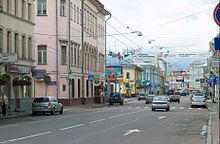Length 0.68 km (0.42 mi) | Postal code 127051, 107045 | |
 | ||
Location Moscow, RussiaCentral Administrative OkrugMeshchansky District Similar Sukharevskaya, Myasnitskaya Street, Turgenevskaya, Chistyye Prudy, Trubnaya ploshchad' | ||
Sretenka Street (Russian: Улица Сретенка) is a street in Meshchansky district of the Central Administrative Okrug, Moscow.
Contents
Map of ul. Sretenka, Moskva, Russia
Sretenka Street goes from Sretenskie Vorota Square to Bolshaya Sukharevskaya and Malaya Sukharevskaya Squares. Numbering of houses is carried out by Sretensky Gate.
The street was named in the XVII century by the Sretensky Monastery, which was located in this street (now part of the Sretenka called Bolshaya Lubyanka Street). The monastery also was named in honor of the deliverance of Moscow from the conquest of Timur's troops in 1395. While waiting for the invasion, the Grand Duke Vasily I of Moscow ordered to move from Vladimir to Moscow the miraculous Theotokos of Vladimir icon. On August 26 (8 September) of 1395 Muscovites came "sretat" Russian: сретать) (old Russian word for 'meet') the icon. In the meeting place of the icon in 1397 a monastery was founded called Sretensky. The old name of the street - Ustretenskaya ( Russian: Устретенская) (the beginning of the XVI century) and Stretinskaya Street.
History
Sretenka Street developed on the way from Moscow to the Trinity Lavra of St. Sergius and was called the Great Vladimir road. In 1395 it was renamed in Sretenka. On the street every day were Orthodox pilgrimage. Orthodox tradition required to pass all the way (68 Verst) by foot.
In the 16th century it was occupied by traders and craftsmen yards Sretensky hundreds (burgher settlement, established on the site of a monastic settlement Candlemas). At the beginning of the 16th century, when the street was called Ustretenskoy for Sretensky gate Candlemas, a new settlement in which they lived among others carpenters, furriers, and other crafsmen. In the second half of 17th century the settlement was named Pankratevskoy "black" Sloboda (Russian: Панкратьевской «черной» слободой). In 1653 the settlement consisted of 168 households.
A Moscow guide from 1884 reported Sretenke and adjacent lanes: "It always dirty, though not poor, constantly swarming area of Moscow. Trade is mainly furniture and basic necessities... Hotels and furnished rooms are extremely small, but great abundance of all sorts of restaurants and taverns middle and lower samples ... "
